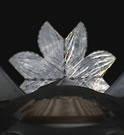 This picture, taken from the rocket, shows the 'clover-leaf' solar sail once it had unfurled.© JAXA
This picture, taken from the rocket, shows the 'clover-leaf' solar sail once it had unfurled.© JAXATwo solar sails have been successfully launched and floated briefly through space before burning up as they re-entered the Earth's atmosphere.
The mission, run by the Japanese Aerospace Exploration Agency (JAXA), aimed to test whether the intricately folded structures would unfurl after launch. It is a promising demonstration of a technology that, some space scientists argue, is our best hope for propelling spacecraft to the stars.
Solar sails are spacecraft without engines. As the Sun's light beats down on the sheet's surface, each photon transfers a small amount of momentum to the sail, accelerating it away from the Sun. The energy involved is tiny, but over considerable time it can boost the sail to tremendous speeds because there is no friction in deep space to slow the craft down.
The Institute of Space and Astronautical Science (ISAS), a division of JAXA, launched the sails in a small S-310 rocket from Uchinoura Space Center in Kagoshima, Japan, at 6:15 GMT yesterday.
At 100 seconds after lift-off, the rocket reached an altitude of 122 kilometres, where it released the first sail. This successfully opened to make a clover-leaf shape about 10 metres across, which was then jettisoned to float through space. A second deployment opened the next sail like a pleated fan at an altitude of 169 kilometres.
Both sails burned up as they entered the Earth's atmosphere moments later, and the rocket splashed down in the Pacific Ocean about 400 seconds after lift off.
Space age origami
The Japanese experiment is quite similar to a Russian space sail, called Znamia, which was released from the Mir Space Station in 1993. But this week's launch tested improved ways of folding a sail, which are crucial for efficiently packing the structure into a small rocket and then deploying it in space.
At only 7.5 micrometres thick, the sails are about ten times thinner than a sheet of paper.
The launch is important because it shows that such large, lightweight structures can be handled in space, says engineer Wolfgang Seboldt of the German Aerospace Centre (DLR) in Cologne, Germany, who led the European Space Agency's solar sail project until earlier this year.
JAXA had already tested their 'fan' deployment method in balloon tests last year, proving that they reign supreme in space age origami. "The Japanese are of course famous for their folding technology," says Seboldt.
Technical difficulties
Solar sail technology has proved difficult to realize because the sail must be large enough to catch the Sun's rays, while still being extremely lightweight and strong. Seboldt estimates that to achieve meaningful propulsion the sail would have to measure more than 50 metres across and weigh less than 100 kilograms.
The European Space Agency put Seboldt's project on hold in spring this year when a financial review concluded that the sail would cost far more than previously thought.
In the United States, the Planetary Society's solar sail has been plagued by technical difficulties. Earlier this year, the society's director Louis Friedman announced that their sail would not launch before November this year. He hopes to use a Russian ballistic rocket to propel the sail into space.
Despite the Japanese success, Seboldt cautions that there is still a long way to go before we see a solar sail mission to the stars, because the exact force that the Sun's rays can exert on a sail remains unknown.
"For a proper test of solar sail technology, it must be launched at least 1,000 kilometres from the Earth's surface," he says. Any closer and there might be interference from gas molecules at the wispy limits of the Earth's atmosphere, he explains, that could obscure the tiny forces delivered by solar photons.
